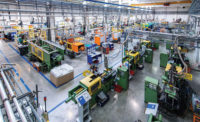ROCKFORD, IL– If the United States addresses four key issues that impact the economy-employment, consumer behavior, global economic strain, and the role of politicians-the country can expect growth of around 3% in 2012, forecasts an economist for a leading manufacturing industry trade group.
“If not, the United States will wallow in the 1 to 1.5% territory, with all that implies,” says Dr. Chris Kuehl, economic analyst for the Fabricators & Manufacturers Association, International (FMA). “The four areas are the ones most people pay close attention to, and are in great flux. Permanent changes in the following four areas will have a significant long-term impact that extends beyond 2012.”
Kuehl says that joblessness is really what most people care about when it comes to the economy. “The average person couldn’t give a hoot about the GDP or trade deficits or the Fed’s interest rate unless it affects jobs,” he explains. “The U.S. economy is now sitting with some 16 million to 25 million people out of work or underemployed.”
Kuehl says this will improve only marginally in 2012. “The rate of joblessness will likely be between 8 and 9.2% for the year,” he notes. “The bigger question is whether those 25 million people will become essentially a permanent underclass.”
According to Kuehl, three aspects make this challenging: many job seekers lack the skills needed to return to the workforce; those who have the skills find it difficult to get to where the work is; and employers that are expanding would rather invest in machines than people.
“Unfortunately, the education system has largely failed to train people for the available jobs,” he explains. “Also, people who were encouraged to specialize in their jobs now find their specific talents are no longer needed. In addition, people who do find jobs in other cities can’t relocate because they can’t sell their home. The regulatory environment hurts hiring, and so does the uncertainty over health care reforms.”
Suddenly, U.S. residents are saving more and deleveraging, Kuehl notes. He says credit card use is down somewhat and so are the bigger loans. “It’s true some of this has been involuntary,” he says. “The majority of the newfound frugality, however, is voluntary, as consumers are now saving at a rate of around 3.2%, a sharp drop from this summer’s 6% , but still respectable for a nation that was engaged in dissaving as recently as 2006.
“The majority of analysts do not expect this frugality to last much longer,” he continues. “Even now there are signs of consumers coming back to life as evidenced by some pretty solid preholiday numbers. As soon as the pressures of unemployment recede somewhat and there is hope of rebound in the housing sector, the consumer may start to return to near normal. This is the key-- near normal--not the crazed consumer of the last decade gobbling up every tiny luxury he could find. The ‘normal’ consumer is the one we saw in the 1980s and 1990s.”
The crisis in Europe has affected the United States for more than a year, Kuehl says. The earthquake in Japan “slammed” the supply chain, which affected the United States to the tune of 1% of gross domestic product (GDP) growth. That disaster cost the Japanese almost 5%, and the world economy lost close to 2% of GDP growth.
Dr. Chris Kuehl is economic analyst for the Fabricators & Manufacturers Association, International (FMA) and managing partner of Armada Corporate Intelligence. Dr. Kuehl is the author of Fabrinomics, a biweekly economic analysis e-newsletter for members of the FMA. For more information go tofmanet.org/fabrinomics .
Get our new eMagazine delivered to your inbox every month.
Stay in the know with Quality’s comprehensive coverage of the manufacturing and metrology industries.
SIGN UP TODAY!Copyright ©2024. All Rights Reserved BNP Media.
Design, CMS, Hosting & Web Development :: ePublishing


